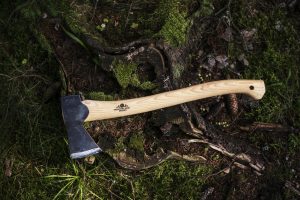The Stone Age is the period in human history that marks the advent of tool production. The name comes from the fact that most of the period’s cutting tools are made from stone. The Stone Age can be subdivided into:
The Early Stone Age, when humans lived by hunting and fishing, which spans the time from the first production of stone tools around 2.5 million years ago to the end of the last Ice Age around 10,000–11,000 years ago – and
The Late Stone Age, which covers the period when farming became the main means of subsistence. Sometimes there is reference to a “Copper Age” as the transition period from Stone Age to Bronze Age.
The axe is one of the oldest tools used by mankind. The oldest axes was known as hand axes.
The hand axe was a pear-shaped and roughly chipped stone tool brought to an even point, with a broad handle. The hand axe was probably used for many different tasks, everything from butchering animals to digging up tubers.
Gradually, the design was refined to include knives, scrapers and arrowheads, amongst other things.
When, much later, the axe was given a wooden handle, several different types of axes were developed, which may be divided into two main groups: Non-shaft-hole axes and shaft-hole axes.

Hand axes had no shaft and were used by Homo ergaster as far back as 1.6 million years ago.
Homo ergaster is the name used for fossils of humans of the Homo genus who lived in Eastern and Southern Africa between 1.9 and 1.4 million years ago.
The species name ergaster comes from the Greek word for worker and was chosen after the discovery of several tools, such as stone axes and cutters, close to skeletal remains from this group.
Non-shaft-hole axes
As the name suggests, the non-shaft-hole axes had no hole for the handle and were generally made from flint, greenstone or slate.
- The core axe is a roughly hewn, unpolished flint axe with a pointed butt and the widest part often towards the cutting edge. The core axe appeared during the Early Stone Age.
- The flake axe is a type of axe made from a large flake chipped from a core, whose edge is used for the broad edge of the axe. Use wear analysis shows that the flake axe was probably used for preparing skins, rather than woodwork or other tasks.
- The Lihult axe (Norwegian Nøstvet axe) is a roughly hewn greenstone axe. The edge is polished and the butt bears signs of hammering. Characteristic of Western Sweden, Southern Norway and particularly the Oslofjord during the latter part of the Early Stone Age.
- The thin-butted axe is usually made from flint, but some versions in other stone occur in both flint-rich and flint-poor areas. They tend to be seen as a working axe, and originate from roughly 3700–3200 BC. The older types are generally longer and broader and have a thinner butt than the later thick-butted axe. The thin-butted axe was good for forest clearing, probably in the context of ring-barking.
- The round stone axe is a greenstone axe with an oval or rounded profile. Only the edge is polished, the rest of the axe is often finely hammered. The round stone axe belongs to the Early Stone Age, but also occurs in large numbers during the early part of the Late Stone Age. It was particularly common in Central Sweden and the lower parts of Northern Sweden. It also occurs in eastern Småland, Bohuslän and Skåne, and on Gotland.
- The hollow-edged axe has a concave blade, like a modern gouge. Axes with a hollow edge may be of different types and occur during different periods. These axes were probably used for woodwork, like a gouge or chisel for example.
The shaft-hole axes
The shaft-hole axes were made using various stones, although not flint, and were more likely to be status weapons or ceremonial objects. Examples of these include the boat axes used in the Battle Axe cultures of Europe in around 3200–1800 BC (read more about the Battle Axe culture below).
- The polygonal axe is a kind of battle axe that belongs to the Late Stone Age and dates to around 3000–3400 BC. It is usually made from greenstone or some other exclusive stone, and is fitted with a shaft hole. It also tends to have various special features, such as a flared edge, an arched butt, an angled body, grooves and ridges. The features are hammered out and then polished across the whole surface. The polygonal axe is seen as a copy of the Central European copper axes, but even in these areas, polygonal axes of various kinds have been found.
- The double-headed battle axe is a shaft-hole axe from around 3400–2900 BC. It occurred mainly around Rügen in Germany and on Zealand in Denmark, as the Battle Axe culture established itself in the surrounding areas. The axe has a flared edge that became very prominent among the later types, which also gained a flared butt. The double-edged axes were always made from hard and homogeneous stones such as porphyry, and they were also finely polished.
- The boat axe is an old name for the shaft-hole axe of the Swedish-Norwegian Battle Axe culture that is now simply referred to as the battle axe. In recent years, the purpose of the battle axe as a weapon has been called into question, not least because the shaft hole is sometimes so small that it could not be attached to a sufficiently strong handle. It may then have served a ceremonial purpose and as an identity marker for the upper echelons of society. Similar axes appeared across a large swathe of North-Eastern Europe, although there are clear differences in the details between different cultural areas.
SKAFTHÅLSLÖSA YXOR & SKAFTHÅLSYXOR








The Battle Axe culture
The Battle Axe culture (c. 3200–1800 BC), also referred to as the Boat Axe culture in older literature, is a relatively uniform archaeological culture that occurs in an area of Southern Sweden-Norway that stretches from Bornholm and Skåne in the south up to Uppland in the north and along the Norwegian coast up to Central Norway.
It is a regional variant of the Corded Ware culture that occurred in North-Eastern Europe during the third century BC. In addition to the battle axes that gave the culture its name and the typical ceramic pots, there are a number of other objects that are characteristic of the culture. These include flint adzes and chisels, which are commonly hollow-edged.
Axes of the Bronze Age
During the Bronze Age (2000 BC – 500 AD for Northern Europe), stone axes began giving way to axes with a head made of copper and bronze. Initially, these were often pure copies of stone axes. The bronze axe head was cast in moulds, allowing the design to be copied and mass produced.
One type of Bronze Age axe is the Socketed Axe, or Celt, a wedge-shaped axe head with no shaft hole. The handle is instead fixed into a socket at the butt end. Since the axe is made hollow and the handle is inserted into the head, a perfectly functional working axe can be made with minimal materials. The older socketed axes were quite long, but they were gradually replaced with smaller types, where a flared edge compensated for the smaller size.
The Palstave is another type of bronze axe that occurred for a short period during the Early Bronze Age (1500 BC – 1000 BC). The characteristic of this axe type is the narrow butt, which inserts into a split wooden handle. The blade is often flared and the sides may be decorated with spiral or angular patterns. The Palstave was mounted in the split end of a wooden handle and then tied in place with leather straps.
In Scandinavia axes in copper and bronze have been found in the Early Bronze Age (c. 2000 BC).
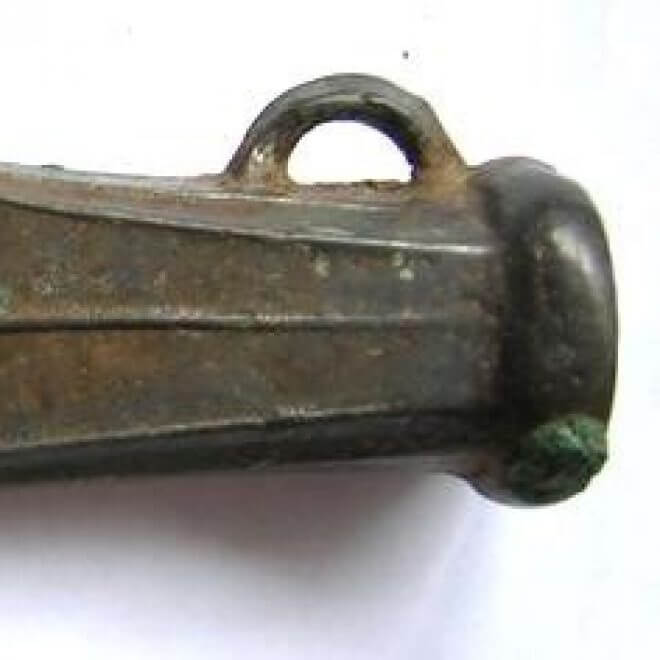
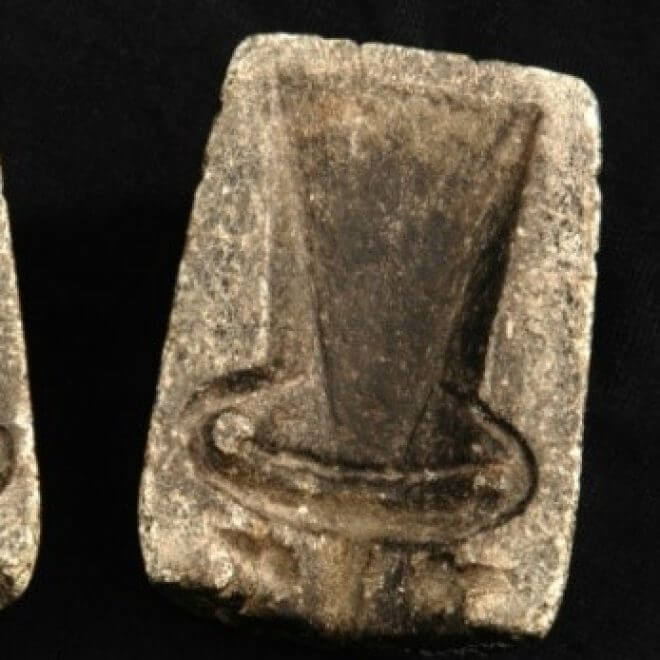
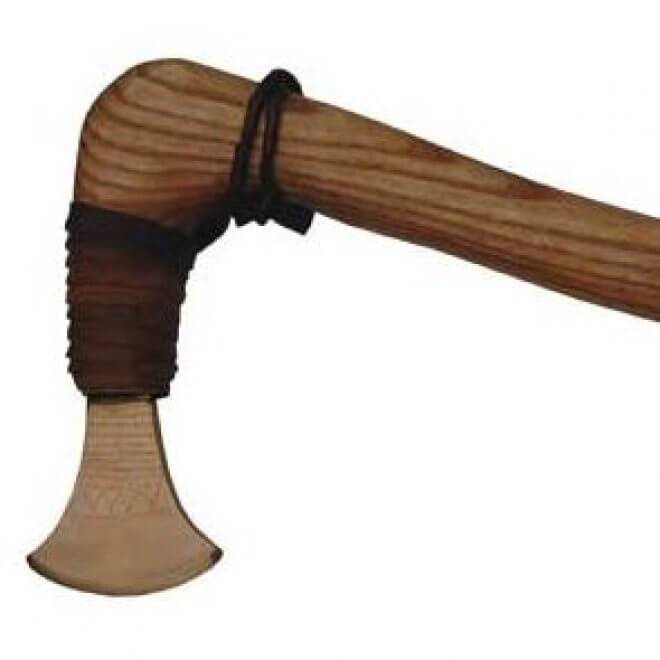
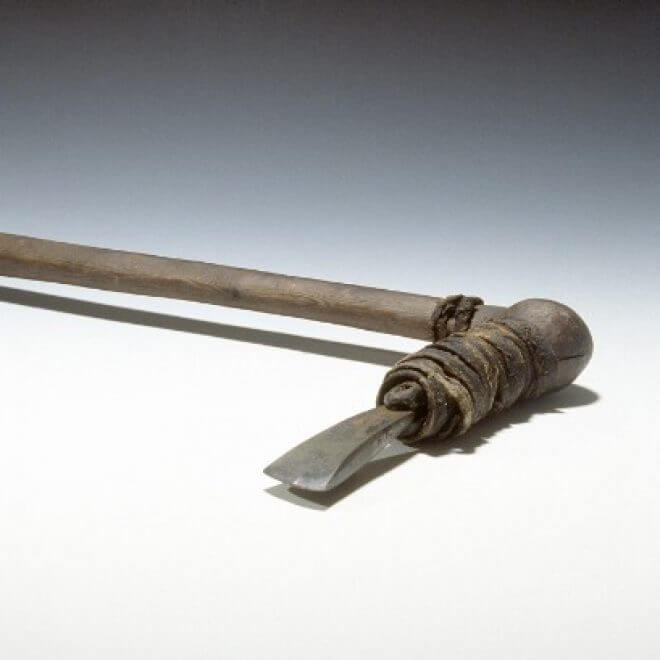
At the beginning of the Iron Age (from c. 500 BC in Northern Europe) the old axe types, such as the socketed axe, were simply reproduced in iron, but the possibilities of the new material led the appearance of the axes to change gradually. The non-shaft-hole axes disappeared and were replaced by axes with a hole for a handle. The axe heads also became larger, with broader blades.
In Scandinavia it has been found iron axes from the first century AD.
Axes as weapons
Along with the club and spear, the axe is one of mankind’s oldest close combat weapons. The first axes used as weapons were probably the same axes that were used as tools, since these were near at hand. However, the focus shifted to developing specific axes for fighting, although “ordinary” axes continued being used as weapons up until recent times. An axe produced with the specific intention of being used as a weapon in combat is called a battle axe. These were being made as far back as the Stone Age and Bronze Age.
An axe intended to be thrown as a projectile is called a Throwing axe. Throwing axes usually had a short handle. Such weapons were used by Teutonic tribes during the era of the Great Migration (400–500 AD), but also by the Franks. The Frankish throwing axes had thick but sharp axe heads and short handles. They were thrown at a distance of 10 or 12 paces from the enemy.
Excavations of Central European graves from the period 500–750 AD uncovered a special axe that has been named the Franziska. This axe was initially used by the Franks, before spreading to the Teutons, Burgundians, Lombards and finally the Goths.
The Franziska was probably used mostly as a hand weapon in close combat – it paid to keep a firm grip on your weapon at all times. It is unlikely that a warrior would throw away his prized weapon and then stand unarmed, although this is said to have happened when the Franks assaulted their enemies in Italy. However, conditions were very different when out hunting with the axe. It was much more difficult to get within arm’s length of a shy animal than an opponent in battle. An axe could, though, be thrown quickly and quietly from a distance with great precision. And if it did miss the target, on the hunt there was time to recover the axe without the threat of attack from an enemy.
The Franziska has an unusual shape and was clearly designed to be an effective throwing weapon. When correctly thrown, a Franziska rotates a number of times in the air before the axe blade hits its target. The axe will rotate once at a distance of 4–5 metres from the target, twice at a distance of 8–9 metres and three times at a distance of 12–13 metres.

In Scandinavia, the Battle axe rose in popularity during the Viking Age (c. 800–1100 AD), when the axe became something of a weapon of choice. During this time, the Nordic smiths developed axes with longer handles and thinner blades, making the axe head extra light for use in battle.
This type of axe was very common at the Battle of Hastings in 1066, for example, as documented in the Bayeux tapestry.
During the Middle Ages and Renaissance (around the 11th–16th centuries), European armies often had two different types of battle axe: a small axe with a short handle, often carried on the belt, and a larger one with a longer handle. The knights often fought on foot, when it was common to use battle axes. It was also common to find axes where the butt ended in an iron spike and the hand was protected by an iron plate on the handle. During the 15th century, knights in Germany and France in particular used special battle axes that were intended to crush the opponent’s metal armour. These axes were heavier, with a shorter handle and a rather blunter edge.
In Central Europe, throwing axes made entirely of iron were used in the late Middle Ages. The handle was usually 25–30 centimetres long and ended in a point. The butt also had a sharp spike and the cutting edge was around 16 centimetres long. In addition to these, there have been many other models of throwing axe.
There were also large battle axes with a broad long head on a long handle. One example is the Bearded axe, which often had an elongated edge with a sabre-like curve called a beard. The lower part of the blade was fixed to the handle with a rivet. The handle was about 1.4 metres long. On some models, the front part of the axe blade was shaped into a hand guard. Bearded axes came in many varieties, with one or more points or hooks. The bearded axe is sometimes referred as the “half-moon”. Other names were “bardiche” and “halberd”. These axes were common in Western and Central Europe during parts of the 14th century, before becoming more widely used, particularly in Sweden and Eastern Europe.
In Europe, the axe declined in popularity as the sword was developed, but it remained a cheap and easily accessible weapon for ordinary people such as peasants at times of unrest and for self-defence against bandits.
The executioner’s broad axe
In Europe, the broad axe gradually began to replace the sword as the tool of choice for beheadings during the latter part of the Middle Ages.
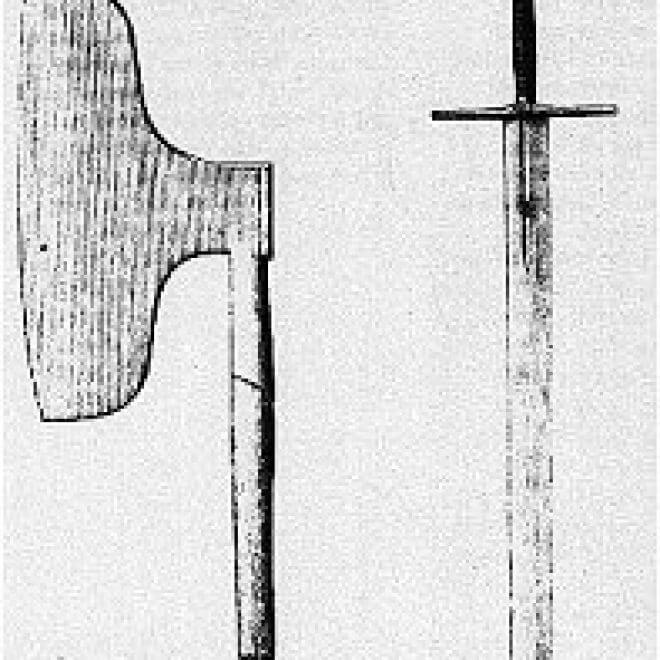
In Sweden, beheading by broad axe was a method of execution used in the 18th and 19th centuries. The final execution with a broad axe in Sweden was that of murderer John Filip Nordlund. It was carried out by national executioner Albert Gustaf Dahlman at Västerås County Jail on 10 December 1900.
The broad axe was then retired in favour of the guillotine for executions in Sweden, although this method was only used once, in 1910, when the last execution took place in Sweden.
The axe as a symbol
Alongside its practical applications, all through history the axe has had a symbolic meaning. As an early example, we have the aforementioned boat axes from the Stone Age. The axe was also a cult object in China, the Inca empire and ancient Greece and Rome.
The Swedish History Museum in Stockholm has a double-headed axe made from clay, overlaid in gold. A clay axe could not have been a tool, only a cult object – with the double-headed axe representing the circle of life. Like the crescent moon that waxed and waned, one can imagine that the two blades of the axe might symbolise birth and death in some form of related ritual.
The Minoan culture flourished in Knossos on the Greek island of Crete in around 2500 BC. Knossos was probably the biggest and most powerful of several centres in the eastern Mediterranean at that time. The enormous Labyrinth palace was home to the ruling dynasty, but also the hub of political and economic life in Knossos. Colourful religious ceremonies and ecstatic cult festivals took place here.
The word “labyrinth” comes from labrys, an ancient Cretan word for a double-headed axe. As the name of the palace, Labyrinth meant House of the Double Axe. Images of double-headed axes have been found carved into stone in Knossos. It is known that the double-headed axe played a major role in Minoan culture and was a symbol of power.
Excavations of the Knossos palace have uncovered a mural of a heavily armed woman who has a double-headed axe in each hand. The House of the Double Axe and the woman with the double-headed axes represented just a few of the symbols and depictions in Minoan society. Religion and ritual were an integrated part of general culture.
Double-headed axe with bull’s head (boukranion) from Mycenaean Greece.
In the Roman Empire, a lictor (a civil servant tasked with attending and guarding the magistrates of the empire) carried a bundle of rods, known as a fasces with a decorative broad axe attached. The fasces symbolized the power to punish. The bundle of rods represented the power to flog and the broad axe the power to execute. Today the fasces can still be seen in the emblem of the Swedish and Norwegian police forces and in the French national coat of arms. Mussolini adopted the fasces as a symbol of his movement, which led to the name Fascism.

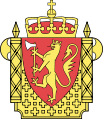
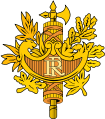
In the Nordic region, the battle axe became a symbol of power and rank during the Viking Age. The axes were ornately decorated as important status symbols. In Norway, the axe became one of St Olaf’s holy attributes.
The axe has also been used as a symbol in the military. The provost marshal, a former non-commissioned officer tasked with keeping order and carrying out punishments, wore a symbolic axe on his uniform. Sappers – military woodsmen – carried a large axe on parade as a symbol of their duty
The axe in religion and mythology
As well as being heavily symbolic, axes have also frequently appeared as attributes in various religions and mythologies.

Ganesha is one of Hinduism’s most worshipped deities. He is the god of wisdom and he helps people to overcome obstacles. Ganesha has an elephant head and four arms, and he holds the whole universe within his enormous stomach.
In one hand, he holds an axe that is used to sever the follower’s ties to the material world.
According to Greek mythology Hephaestus, god of blacksmiths, struck Zeus, Father of the Gods, over the head with his double-headed axe. Athena, goddess of wisdom, is said to have leapt from the cloven head of Zeus, fully grown and armed. The event is depicted in an Athenian bowl from 560–550 BC.
Athena was the goddess of civilisation (the well-ordered life), wisdom and feminine crafts. She was also the goddess of strategic war, tactics, skill and planning. Her brother Ares was the god of bloodthirsty, untamed war.
Athena’s birth was remarkable. One of Zeus’ lovers, Metis, fell pregnant. Zeus heard a prophecy that a child of Metis would be mightier than him. As soon as he heard this, he transformed Metis into a fly and swallowed her.
Sometime later, Zeus had a terrible headache. Eventually he could stand it no longer, and he asked Hephaestus, god of blacksmiths, to open his head and find whatever was causing the pain. Hephaestus struck a hole in Zeus’ skull and out sprang Athena. Although Metis had been eaten, the child had survived and grown into an adult women inside Zeus. Now she was tired of her confinement and wanted to get out!
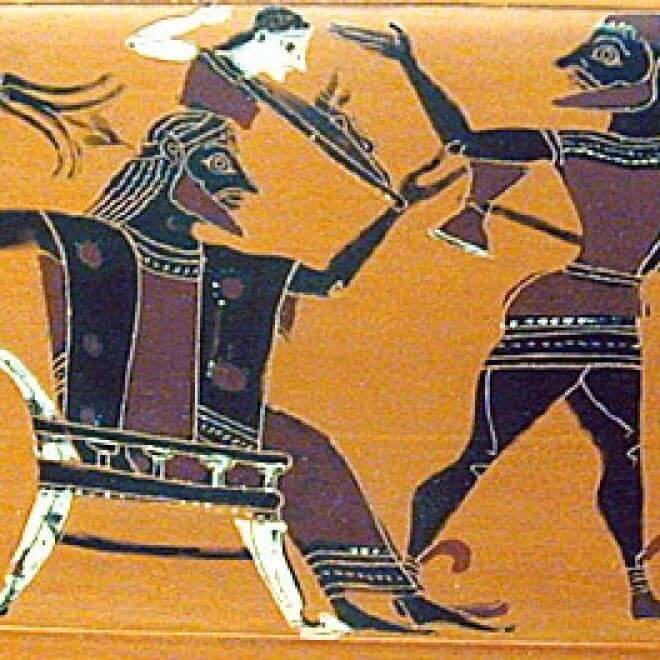
The Iliad (thought to have been written by Homer in c. 700 BC) relates the long journey of Odysseus. While Odysseus is away, his wife Penelope is approached by many suitors. Penelope sets several tests for the suitors. For the last one, she shows them Odysseus’ bow and says that she will marry anyone who can shoot an arrow through the hole in 12 axes in a row. One after the other they try, but they are unable to even pull back the bow. Odysseus, who has just returned disguised as a beggar, asks to have a go and shoots the perfect arrow through the 12 axes.
Chinese mythology relates that the world was created by the giant Pangu. After he was born, he took up an extremely heavy axe and split the egg from which he had emerged into two parts with one powerful stroke. The lighter parts of the egg were flung upwards to form the sky, and the heavier parts fell down and created the earth.
The Bible also mentions an axe in the Second Book of Kings, where the prophet Elisha rescues an axe head that has fallen into the water by making the iron float to the surface again. The story may have given rise to the Swedish expression “To throw the axe in the lake”, which means to give up on a hard task.
Forestry companies turned axe making into an industry
Before industrialisation, axes were manufactured at numerous small forges. The design and structure of the axe were determined by its function, the user’s requirements and the craftsmanship of the axe smith. Until the mid-19th century, axes were used for small-scale tasks by craftsmen and self-sufficient farming communities.
The aggressive logging that came with industrialisation brought brand new axe customers on a large scale: forestry companies and specialist forest workers. The increase in demand for axes made axe manufacture of more commercial interest and it was concentrated in axe factories.
Long runs and production efficiencies lowered the cost of manufacture. Axes became standardised, mass-produced industrial products and large amounts of energy went into ensuring that the axes met the demands of the time regarding how an industrial product should look. All axes of a particular model were supposed to look exactly the same.
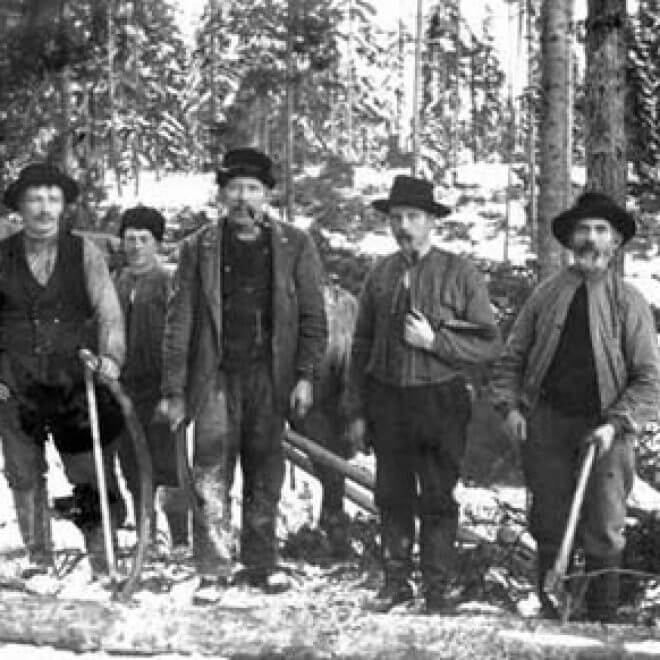
When chainsaws appeared in the 1960s, they replaced axes in forestry work and the axe industry came under immense pressure. Sales of axes fell dramatically and many axe forges ceased trading.
Those who kept going had to rationalize their operation severely to reduce production costs and survive. The axes were made as quickly and cheaply as possible, often at the cost of both function and quality.
Axe manufacture today
The millions of cubic metres of pulpwood and timber processed by the forest industry have never been near an axe. Chainsaws and harvesters have taken over completely. Axes are now used instead in farming, in the home, in outdoor pursuits and so on for small jobs, just as they were before the forest industry took off.
Since the chainsaw outcompeted the axe in forestry, many axe forges have closed down. The USA, for example, is said to have had over 600 axe manufacturers at one time, but now only a few remain. In Canada, which once had numerous axe forges, there are none at all.
From a peak of over 20 axe manufacturers in Sweden, by 2013 there were only three left: Hultafors/Hults Bruk in Åby, S.A. Wetterlings in Storvik and Gränsfors Bruk in Gränsfors. Finland has Fiskars, whose product portfolio includes axes. Norway and Denmark no longer have any major axe manufacturers.
Production at Gränsfors Bruk looks very different now, compared with 50 years ago. Professional craftsmanship is allowed to take the time it needs and piecework has been abandoned. The most important factor is quality, not quantity.
A few of the axes in our museum.
-
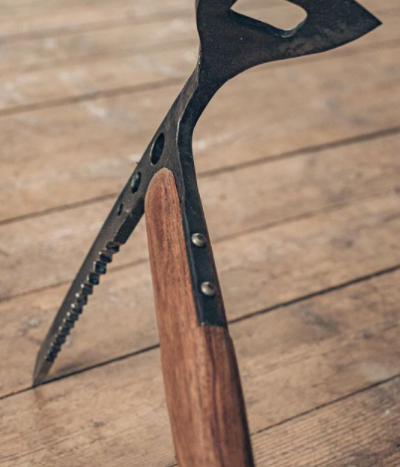 The Ice Pick
The Ice Pick -
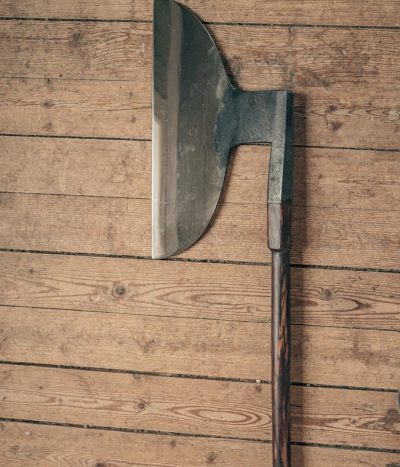 The Executioner’s Axe
The Executioner’s Axe -
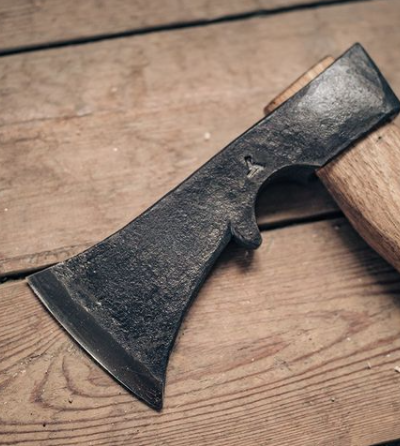 The Shepherd’s Axe
The Shepherd’s Axe -
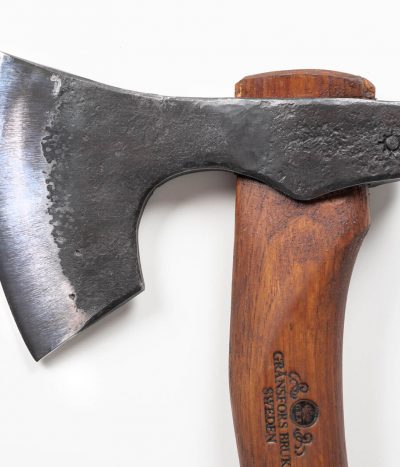 Double-Lugged Bearded Axe
Double-Lugged Bearded Axe -
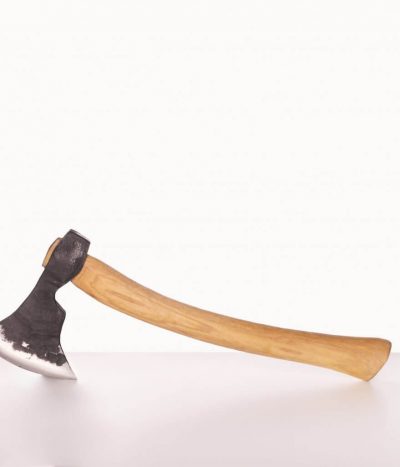 Swedish Viking Axe
Swedish Viking Axe -
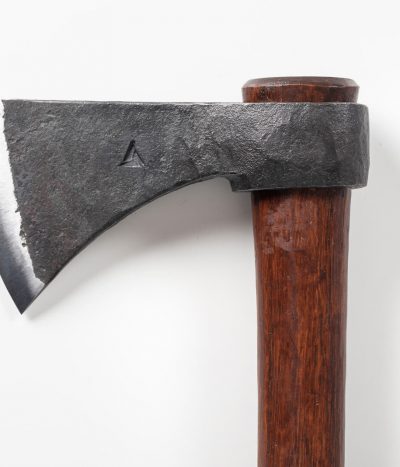 Tomahawk British Trade Axe
Tomahawk British Trade Axe -
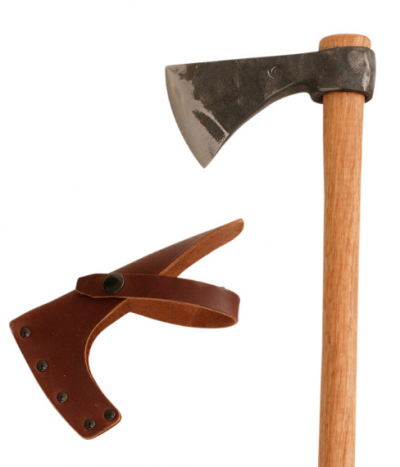 Tomahawk French Trade Axe
Tomahawk French Trade Axe -
 Bearded Axe with Eye-Socket
Bearded Axe with Eye-Socket -
 Danish Broad Axe
Danish Broad Axe -
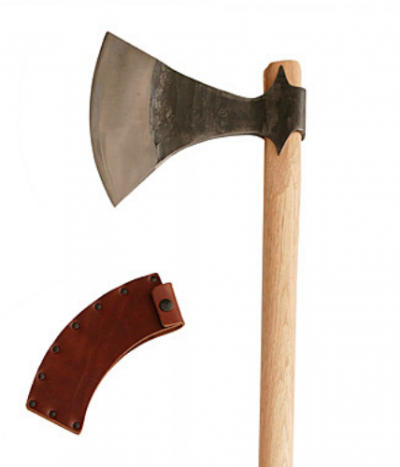 Battle Axe
Battle Axe -
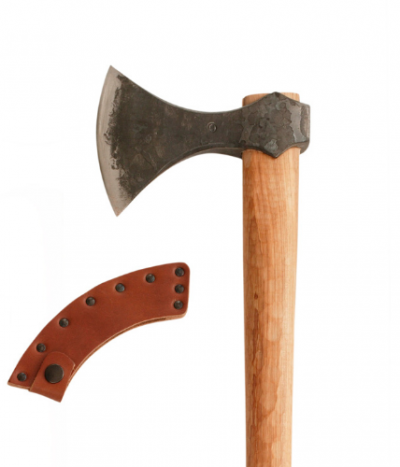 Four-Lugged Chopping Axe
Four-Lugged Chopping Axe -
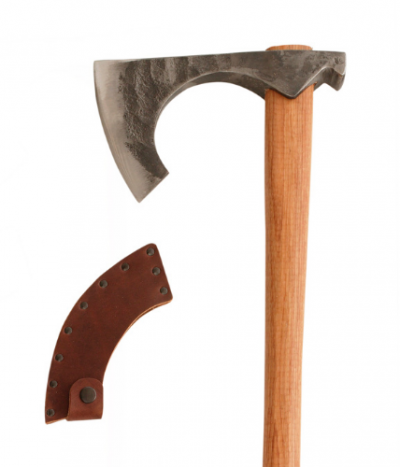 Two-Lugged Beard Axe
Two-Lugged Beard Axe -
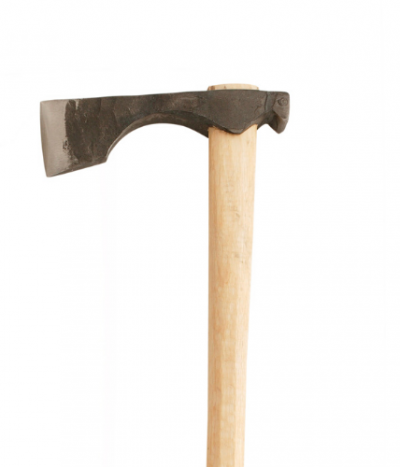 Two-Lugged Chopping Axe
Two-Lugged Chopping Axe -
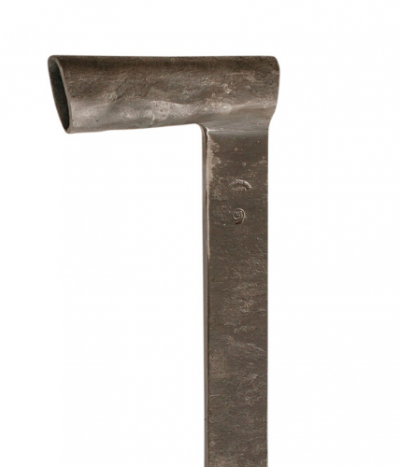 Push-Style Mortise Axe
Push-Style Mortise Axe -
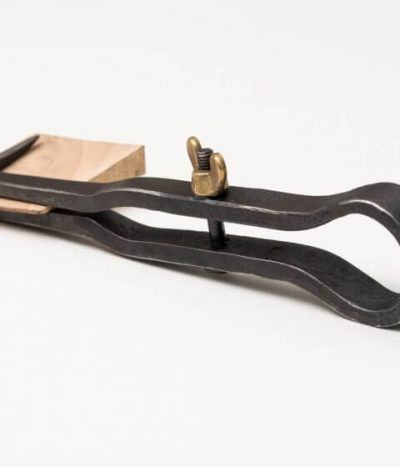 Log Scribe
Log Scribe -
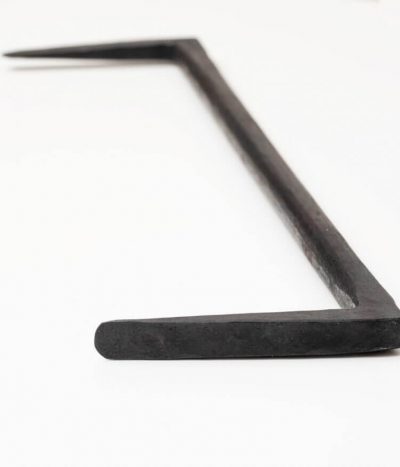 Log Dog
Log Dog -
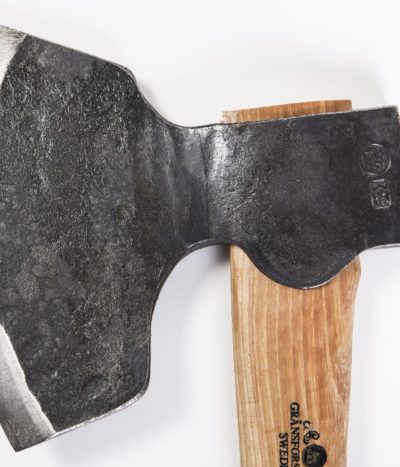 Swedish Broad Axe 1700
Swedish Broad Axe 1700 -
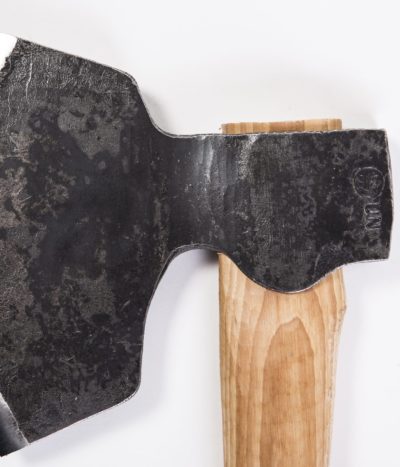 Swedish Broad Axe 1800
Swedish Broad Axe 1800 -
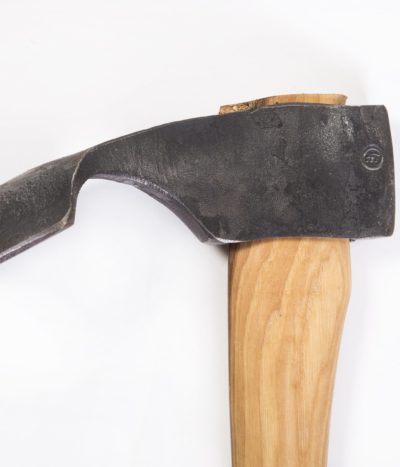 Large Gutter Adze
Large Gutter Adze -
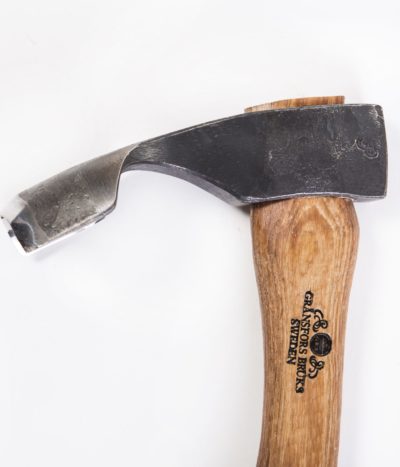 Small Gutter Adze
Small Gutter Adze -
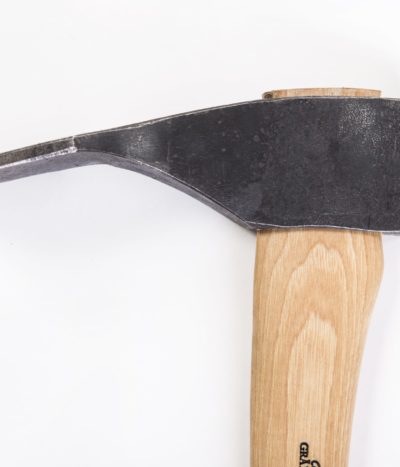 Large Straight Adze
Large Straight Adze -
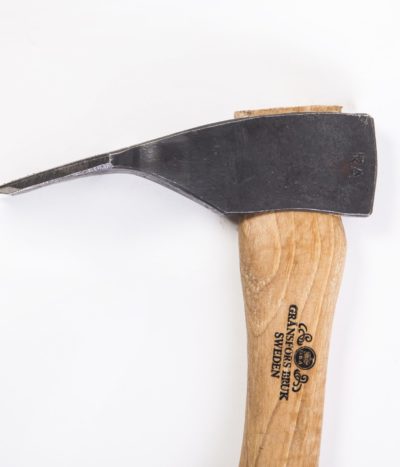 Small Straight Adze
Small Straight Adze -
 Large Carving Axe – Beech
Large Carving Axe – Beech -
 Small Carving Hatchet – Beech
Small Carving Hatchet – Beech
 Distributed in the USA
Distributed in the USA

